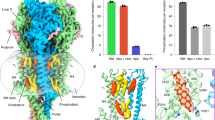Summary
The agonist concentration—endplate conductance relation was examined for a number of agonists (such as carbachol, alkyl trimethylammonium salts, choline and decamethonium). The endplate current evoked varied asI max [a/(a+K)]2, wherea is the agonist concentration andI max andK are agonist-specific parameters. This finding suggests that the endplate receptor has 2 equivalent subunits which bind agonist approximately non-cooperatively. The liganded subunits then switch to an active conformation with a probability that depends on the nature of the agonist. Both subunits must adopt the active conformation for the channel to open, but the transitions of the subunits could be either independent or concerted.
Similar content being viewed by others
References
Adams, P. R.: Drug concentration-conductance curves at frog end-plates determined by voltage clamp. J. Physiol. (Lond.)241, 7–8 (1974a)
Adams, P. R.: Ph. D. Thesis, University of London (1974b)
Adams, P. R.: A study of desensitization using voltage clamp. Pflügers Arch.360, 135–144 (1975)
Anderson, C. R., Stevens, C. F.: Voltage clamp analysis of acetylcholine produced end-plate current fluctuations at frog neuromuscular junction. J. Physiol. (Lond.)235, 655–691 (1973)
Brookes, N., Werman, R.: The cooperativity of γ-aminobutyric acid action on the membrane of locust muscle fibres. Molec. Pharmacol.9, 571–579 (1973)
Castillo, J. del, Katz, B.: Interaction at end-plate receptors between different choline derivatives. Proc. roy. Soc. B146, 369–381 (1957)
Dreyer, F., Peper, K.: Density and dose-response curve of acetylcholine receptors in frog neuromuscular junction. Nature (Lond.)253, 641–643 (1975)
Hill, T. L., Chen, Y.-D.: On the theory of ion transport across the nerve membrane. II. Potassium ion kinetics and cooperativity (withx=4). Proc. nat. Acad. Sci. (Wash.)68, 1711–1715 (1971)
Jenkinson, D. H.: The antagonism between tubocurarine and substances which depolarise the motor end-plate. J. Physiol. (Lond.)152, 309–324 (1960)
Jenkinson, D. H., Terrar, D. A.: Influence of chloride ions on changes in membrane potential during prolonged application of carbachol to frog skeletal muscle. Brit. J. Pharmacol.47, 363–376 (1973)
Katz, B., Thesleff, S.: A study of the “desensitisation” produced by acetylcholine at the motor end-plate. J. Physiol. (Lond.)138, 63–80 (1957)
Porter, C. W., Chiu, T. H., Wieckowski, J., Barnard, E. A.: Types and location of cholinergic receptor-like molecules in muscle fibres. Nature New Biol.241, 3–7 (1973)
Takeuchi, A., Takeuchi, N.: Active phase of frog's end-plate potential. J. Neurophysiol.22, 395–411 (1959)
Author information
Authors and Affiliations
Rights and permissions
About this article
Cite this article
Adams, P.R. An analysis of the dose-response curve at voltage-clamped frog-endplates. Pflugers Arch. 360, 145–153 (1975). https://doi.org/10.1007/BF00580537
Received:
Published:
Issue Date:
DOI: https://doi.org/10.1007/BF00580537



